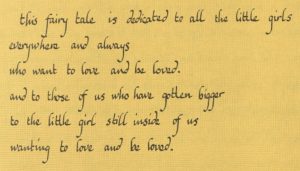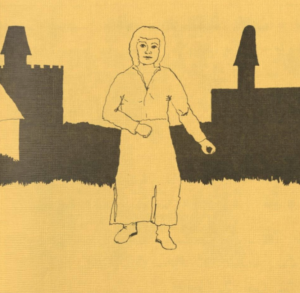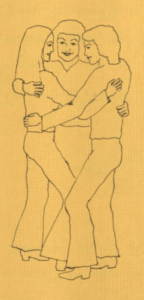
The Dedication for Sleeping Beauty: a lesbian fairytale, published in 1971, lettering by ginny
Sleeping Beauty: a lesbian fairy tale by Vicki Gabriner is a lesbian retelling of the story of Sleeping Beauty. The story is dedicated to “all the little girls everywhere and always who want to love and be loved” (Gabriner iii). This lesbian children’s fairytale is revolutionary because it represents lesbians in a children book and provides an alternate story to the original Sleeping Beauty that can be passed down for generations. This retelling of Sleeping Beauty is also a way of symbolically showing how lesbians have been a part of history for as long as Sleeping Beauty and stories like it have been told; they just have never been documented. This book uses the power and renown of the original story to show the power and beauty of lesbian identity. Claiming this power means that lesbian erasure and lack of recording history will not happen again.
The story of Sleeping Beauty: a lesbian fairytale is mostly just a retelling of Sleeping Beauty until the end. The King and Queen give birth to a baby girl, who’s name is Stephen. At the dinner to celebrate her birth, they invite all but one of the witches in The Land. The witch, named Gertrude, who wasn’t invited, comes anyway and curses Stephen to prick her finger and sleep for a hundred years. On her fifteenth birthday, Stephen pricks her finger and falls asleep. This is where the story changes: the person who kisses the princess to wake her up is a girl named Lilith. They fall in love and rule as queens until they decide to release their servants and create a lesbian paradise.

The witch, Gertrude, illustrated by gail in Sleeping Beauty: a lesbian fairytale, published in 1971
The witch, Gertrude, in this story is not evil and mean like she is portrayed in the original. Gertrude is excluded from the party, not because of any evil nature because she “cut her hair quite short,” “walked like a man,” and “was different” (Gabriner 3). The King and Queen didn’t like her “because they sensed [her] freedom and [her] love for other women” (Gabriner 25). Gertude curses Stephen not out of spite, but because Gertrude knew that Stephen needed to sleep for a hundred years in order to meet her truelove, Lilith: “it was in the stars” (Gabriner 25).

Gertrude, Lilith and Stephen embrace after Lilith awakens Stephen, illustrated by gail in Sleeping Beauty: a lesbian fairytale, published in 1971
The guidance Gurtrude gives to Stephen and Lilith is a symbol for the guidance and activism older generations of lesbian have given and continue to give to the younger generation. This guidance helps to create a better society where “all women … live and work together as equals” (Gabriner 29). This story shows gratitude to the previous generations of lesbians for their activism. The intergenerational communication and help is vital to the continuation of the lesbian feminist movement. This communication is facilitated by the ability of archives to preserve access to this guidance and celebrate the work of previous generations.
Works Cited:
Gabriner, Vicki. Sleeping Beauty : a lesbian fairy tale. Sojourner Truth Press, 1971.
